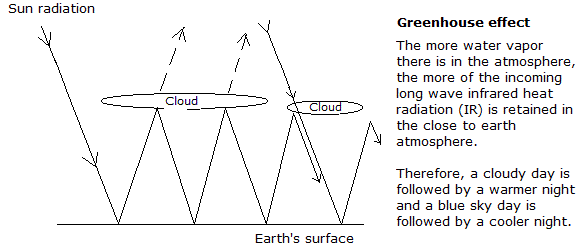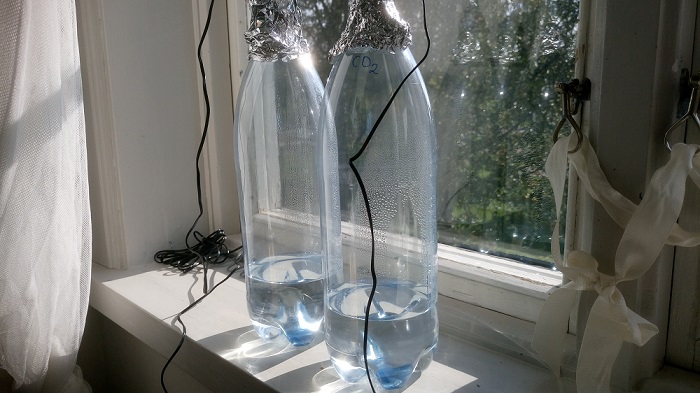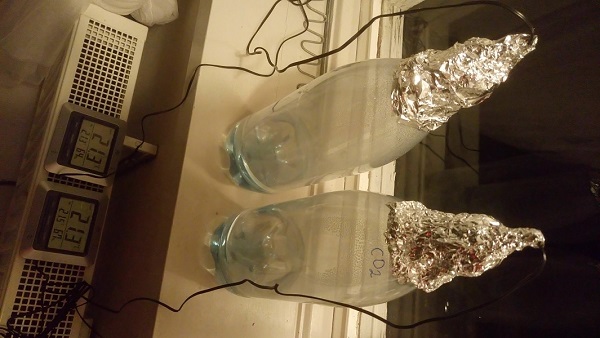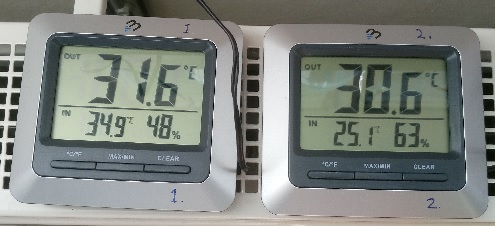1. Radiation in general
2. Greenhouse effect
3. How does the greenhouse effect work?
4. Which are the greenhouse gases?
5. Carbon dioxide as a greenhouse
gas - laboratory experiment
Radiation in
general



Task: Determine if carbon dioxide has a warming
or cooling effect as "greenhouse gas".
Material: 2 thermometers (preferably digital
thermometers), two mineral water bottles with carbonated
water, aluminum foil, silver tape, space behind sunny
window.
Arrangement: The thermometers must be
synchronous, i.e. showing the same "temperature" (oC) at
the same temperature. They should show 0 oC in ice water
and 100 oC in boiling water. If they would deviate a
little, then one must find out how they differ from one
another.
Remove the labels from the pet bottles. It's easy if the
labels are plastic and are loose. Pour water from the
pet bottles so that there is about 7 cm of water left in
one bottle. Let all the carbonic acid (carbon dioxide
solved in water) in this bottle be degassed for a few
days. Shake the bottle and have open cap. Make a small
hole in the cap so that either a laboratory thermometer
(rod thermometer) or digital thermometer can have its
sensor about 3 cm down in the bottle. You can melt hole
in the cap with a metal awl heated over a candle. Fix
the thermometer's sensor with duct tape and don't
leave the sensor in contact with the inner wall of the
bottle but it should be free. Make sure the cap of the
second bottle also gets a hole with the thermometer
sensor in the same way as in the first bottle. Fix with
duct tape and seal as good as you can. Let the amount of water in the second
bottle be equal to that in the first bottle. Leave the
carbonic acid in the bottle. Cover the top of the pet
bottles equally with aluminum foil so that the sun
cannot shine directly on the sensors. Leave both bottles
behind window towards the south and wait for sunshine.
Make sure the gas pressures in the bottles are the same,
i.e. gas must be able to pass out or into the bottles
depending on different air pressures - there must be the
same pressure conditions in both bottles. This is
achieved even if you seal well with duct tape.
Set-up: acc. figure below, and as described in
the text under "arrangement". You can execute the
experiment in different sunny windows to see possible
deviations.
Result: The consistency of the thermometers: The
thermometers show the same temperature at the same
"temperature".

The picture shows the experiment at night at room
temperature (the radiator is not on).
Sunlight temperature (pictured below): bottle # 1, which
has only atmospheric water vapor above the surface of
the water (common air), starts to get a higher
temperature compared to bottle # 2, which has extra
carbon dioxide in its atmospheric gas. As can be seen in
the picture below, the temperatures differ about one
degree Celsius.
At night without sun exposure, it was the same
temperature in both bottles. So it was night after night
and even day after day when the sun was not on. The
temperature was the same in both bottles. As soon as the
sun began to shine on the experiment and the temperature
increased, a temperature deviation between the bottles
of about a degree Celsius occurred. The experiment was
up for about two weeks and the result was the same every
time the sun shone on the bottles and especially when
the temperature reached 30 degrees or more. Initially,
the carbon dioxide concentration in bottle 2 needed to
decrease a little before we reached the elevated carbon
dioxide levels that caused the temperature drop during
sunshine.
Conclusion: Carbon dioxide (in this experiment)
seems to reduces the heat-holding
effect of the atmosphere, and contributes to cooling of
the atmosphere, compared to water vapor. Carbon dioxide
contributes to a decreasing "greenhouse effect", and has
a cooling effect on the Earth's atmospheric climate, as
greenhouse gas.

The picture above shows the sun shining on
the pet bottles. Below is the temperature in the two
bottles.

Discussion:
The ideal gas law:
p * V = n * R * T
p = pressure (N / m2)
V = volume (m3)
n = amount of substance (number of moles; 1 mole = 6.02
* 1023 pcs of molecules or atoms)
R = gas constant (8.3145 J / (mol * K))
T = absolute temperature (K (Kelvin))
In the experiment, p, V, R can be considered constant.
This means that as the temperature rises, the number of
molecules in the gas decreases. Similarly, as the
temperature decreases, more molecules are allowed into
the atmosphere of the bottle.
As the temperature rises, collisions of gas particles
increase. The pressure is the same in both bottles,
which means that there are fewer gas particles in bottle
1 (air) compared to bottle 2 (air and extra carbon
dioxide). As bottle 2 has a lower temperature, more gas
particles are allowed to be present in the atmosphere of
the bottle.
An addition of carbon dioxide to the air causes some
water vapor to condense into water. This can be seen if
two pet bottles like bottle # 1 are set up (regular air
in both). Let these bottles be for a while. Then in
bottle 2 dissolve a little baking soda in
the water and a little acetic acid is then poured in.
The chemical reaction that takes place creates carbon
dioxide which goes up in the atmosphere of the bottle
according to the reaction:
Sodium hydrogen carbonate (baking soda) + acetic acid  sodium acetate + water + carbon dioxide
sodium acetate + water + carbon dioxide
NaHCO3 + CH3COOH  CH3COONa + H2O + CO2
CH3COONa + H2O + CO2
This makes water vapor condense on the inside of the
bottle (or disappear from the bottle). The heat-retaining property of the atmosphere
("greenhouse effect") decreases and the temperature
drops. Carbon dioxide is a poorer greenhouse gas
compared to water vapor, which means that an extra
carbon dioxide addition to the earth's atmosphere lowers
its temperature. Thus, it cannot be said that carbon
dioxide would raise the temperature of the earth's
atmosphere, since water vapor is not allowed in the
atmosphere in the same amount as before the carbon
dioxide addition.
The result is that Carbon Dioxide reduces the Earth's
atmospheric current greenhouse effect and temperature.
Here are sources of error for this lab which must be
taken into account. This laboratory does not show an
absolute scenario for the greenhouse effect for the set
up leaves some question marks and the interactions
between the incoming gases are also complicated as they
all have different properties.
That the cork is open with a little leakage:
==================================
When the sun is on, gas from the bottle will leave the
bottle. To say with this experiment that both bottles
leak the same amount of gas - that would be a false
statement. As the sun diminishes, outside air enters the
bottle - a small "breath" of the bottle. On the other
hand, under constant sunshine and rising temperatures,
we can say that the flow of gas should be directed
outward from the bottles.
The temperature sensor:
====================
This should be centered in the bottle and at the same
height. Nor can this be guaranteed.
Convection:
==========
Bottle No. 2 with carbon dioxide may have two main
convection cells (warmer air rises and colder drops).
Carbon dioxide is a heavier (CO2; 0.04%, 44
g/mol) gas than air containing mainly Nitrogen gas (N2,
78%, 28 g/mol), Oxygen (O2, 21%, 32 g/mol)
and Argon (Ar, 1%, 40 g/mol). We assume that if the
carbon dioxide content is quite high in the experiment,
then carbon dioxide itself will have convection cells
above the water surface. Remained air will have
convection cells above these, and could also have a
lower temperature. Now this experiment has also been
done with the temperature sensors placed further down in
the bottles as well, and the experiment has still shown
that when the sun is on, bottle # 2 with a little added
carbon dioxide has a lower temperature. We assume that
the carbon dioxide is mixed in the experiment when its
content is low and the lid is minimal-leakage-open. To
minimiza low-temperature convection above the carbon
dioxide convection cells, the aluminium foil would stop
this, whereas the sun cannot shine throught the
aluminium foil and heat the gas in the upper part of the
bottle where the temperature sensor is.
Warning - there are errors in laboratory set ups that
want to show that carbon dioxide raises atmospheric
temperature.
- These are carried out today in schools.
==================================================
==========================
Several laboratory set-ups with a reference bottle have
been set up in schools around the world to demonstrate
the warming effect of carbon dioxide in an atmosphere.
These experiments have been designed to show that carbon
dioxide is responsible for the temperature rise between
the years 1980 and 2000. Experiments have been set up to
"prove" this. Here are the two most common laboratory
setups that show this fraud.
IR lamp on reference pet bottle with air (1) and
bottle with carbon dioxide (2):
==================================================
===========
No water is in the bottles. There can be air in one
bottle (1) and only carbon dioxide in bottle 2. The
bottle with air then contains: 21% oxygen, 78% nitrogen,
1% Argon and minimal water vapor and carbon dioxide. The
second bottle then contains pure carbon dioxide gas
(100%). It goes without saying that the second bottle
with carbon dioxide alone will show a higher
temperature, since carbon dioxide is a greenhouse gas.
The first bottle contains transparent gases (oxygen,
nitrogen) that do not absorb solar radiation. In this
way, one cannot set up an experiment as it goes without
saying that a bottle with only greenhouse gas shows the
highest temperature. With such an arrangement you want
to show that a higher carbon dioxide atmosphere shows
higher temperature.
E.g. these types of laboratory experiments:
https://www.rsc.org/Education/Teachers/Resources/jesei/co2green/home.htm
https://serc.carleton.edu/eslabs/weather/2d.html
In the reference bottle with ordinary air, the humidity
will not increase significantly - which is normal in
nature. More water vapor will not be supplied to the
air, which means that hardly any extra water vapor can
come to the rescue and help store the heat in the
bottle's atmosphere.
IR lamp
====================
It is not possible to use an IR lamp because the IR lamp
(short and long-wave heat radiation) is not the same as
sunlight. The IR lamp heats the CO2 gas
directly (not "greenhouse effect") but cannot heat the
air in the reference bottle. The sun is very far away.
Absence of water in the bottles
=========================
70% of the earth is covered with water and water is
found in soil and atmosphere. As the carbon dioxide
content increases, water will condense. A good
greenhouse gas (water) will be replaced by a bad
greenhouse gas (carbon dioxide). The heat-retaining
effect in the atmosphere gets worse and the "system"
works to counteract a rise in temperature. In several
school experiments, water is missing in the containers
and the phase transitions of water are not taken into
account.
Specific heat capacity
====================
To raise air 1 degree centigrade or Kelvin, 1.01 KJ /
(kg * K) is needed. Here comes specific heat capacity
for some gases.
Air 1.01 KJ / (kg *
K)
CO2 0.84 KJ / (kg *
K)
Ar 0.52 KJ /
(kg * K)
Cl2 0.48
KJ / (kg * K)
CH4 2.22 KJ /
(kg * K)
H2O 4,19 KJ / (kg
* K)
Thus, less energy is needed to heat carbon dioxide one
degree compared to air. From this, the temperature rises
faster in carbon dioxide. The temperature rises even
faster in chlorine gas.
Baking powder and acetic acid
=========================
When using baking powder and acetic acid in water to
produce carbon dioxide and using an excess of acetic
acid. Here you can feel the smell in the bottle that its
atmosphere is stinging. Acetic acid dissolves into the
water vapor and we get dissolved acetic acid in the
water vapor. In order for this experiment to be
reasonably in accordance with nature, it must be
calculated exactly how much acid is needed and exactly
how much baking powder is needed to raise the carbon
dioxide content to a certain level, e.g. 900 ppm or 1%
or similar. Everything must react in the reaction and no
extra acetic acid may be present, which dissolves in the
water vapor and gives a pungent odor. This experiment
Adrian Vance has done and reported in his book "Vapor
Tiger". He shows that at 910 ppm carbon dioxide, the
atmospheric temperature drops 1 degree compared to
normal air.
Extra applicable dimensions of the universe:
====================================
This experiment is three-dimensional with the room's
three axes x, y, z and time. The universe is made up of
more dimensions (10 in total) which also obviously
affect the experiment, but much research remains.
Bottle Material
============
This material can absorb some type of radiation - here
may be a source of error.
Using tap water
=======================
Tap water may contain e.g. chlorine gas or other
additives that could affect the result. Chlorine gas has
a lower specific heat capacity and could give a
temperature increase. Use mineral water instead.
Other
=====
We will update this lab further. If you have any
comments, please enter them below in the comments field
or send an email.
References
===========
https://principia-scientific.org/the-deliberately-false-greenhouse-gas-co2-experiment/
http://www.climatechangeeducation.org/hands-on/difficulties/heating_greenhouse_gases/
http://www.rsc.org/Education/Teachers/Resources/jesei/co2green/home.htm
https://serc.carleton.edu/eslabs/weather/2d.html
https://www.researchgate.net/figure/Greenhouse-Gas-Bottle-Demonstration-97-Bottles-with-CO2-and-air-are-radiated-and_fig77_324751934
http://chem-www4.ad.umu.se:8081/Skolkemi/Experiment/experiment.jsp?id=74
The book "Vapor Tiger" by Adrian Vance (recommended
reading).
https://webapps.kemi.se/flodesanalyser/Amnesinformation/attiksyra_sv.htm
The search engine google shows in its search results
only bottle labs which, on closer examination, mislead
to give a definite view that extra carbon dioxide to the
atmosphere raises the atmospheric temperature. In the
experiment above, we show the opposite. Use the search
engine e.g. Yahoo instead to compare.
* More water vapor will stay in the atmosphere. This in turn makes the atmosphere even warmer as water vapor itself is a greenhouse gas. (If more carbon dioxide were present in the atmosphere, some water vapor would condense, which would even out a temperature increase).
* The water in the world oceans will expand as hot water takes up more space than cold. This expansion is likely to continue for several hundred years before equilibrium has been reached.
* Currents in the oceans can change direction. If the Gulf Stream were to change direction, our temperature in the north would probably drop slightly.
* Climate zones could be moved on Earth.
* As cyclones grow in power over water due to the water's heat content, more of these will be created. They will also become more violent. We can expect huge weather changes and extreme wind speeds, even closer to our latitudes.
* Case 1: Warmer climates will partially melt the North and South Poles' ices, which means that the sea level would come to rise.
* Case 2: The increased amount of water vapor that stays in the atmosphere means that it will rain more. This would lead to more snow on the poles. The water from the oceans of the world would instead be bound up in the polar ices. The water level of the oceans would thus be lowered.
Copywrite NGU, Northern Pontifical Academy 2025 (A.I.C.)